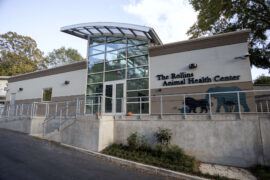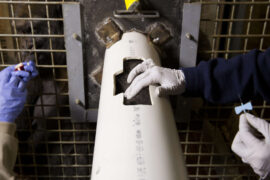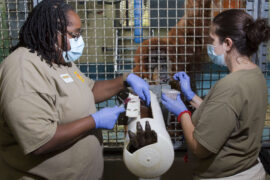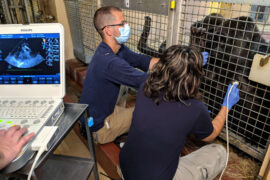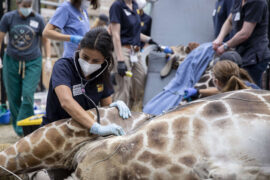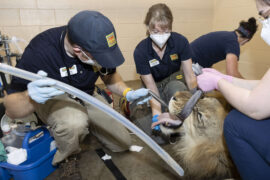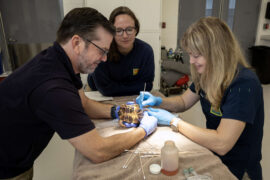Animal Care
Animal Health: Vital Animal Care
Zoo Atlanta’s Animal Health and Nutrition Teams, regulated by the Association of Zoos and Aquariums (AZA) and the U.S. Department of Agriculture (USDA), work side by side with the animal care teams in ensuring all species at the Zoo are in optimal health.
From advancements at the Zoo to collaborating with global partners, Zoo Atlanta’s world-class Veterinary Team is dedicated to providing the highest standards of care. Animals thrive at Zoo Atlanta because of the innovative, individualized, and high level of medical care they receive.
The Rollins Animal Health Center
Breaking ground on July 27, 2023, Zoo Atlanta’s Rollins Animal Health Center was designed to redefine standards of excellence in zoo animal medicine, state-of-the-art technology, research, and academic partnerships.
Read moreVeterinary Team
Our Veterinary Team includes associate and board-certified veterinarians and veterinary technicians, on grounds during business hours and on call in cases of emergencies.
The Veterinary Team uses a variety of measures to care for the animals, including:
- Preventative medicine
- Routine medical/dental exams and vaccinations at the Silberman Diagnostic Center
- Routine screening tests via blood work or fecal samples
- Routine quarantining of new animals that arrive from other zoos
- Research
- Clinical: Regular peer-reviewed papers in veterinary journals
- Conservation
- Great Ape Heart Project headquartered at Zoo Atlanta
- In situ research
Animal Welfare
Making sure animals have a high standard of welfare
Animal welfare is an integral part of the Zoo’s mission and our animals’ daily care. Learn more about what’s involved and how we measure it.
What is animal welfare?
Welfare is an animal’s collective physical, mental, and emotional state over a period of time, and is measured on a continuum from good to poor.
Why do we measure welfare?
Zoo Atlanta uses evidence-based animal care to promote the highest standards of well-being—one way of doing this is by measuring welfare.
How do we measure welfare?
In addition to animal care professionals monitoring the animals daily, we employ a number of measures of welfare, including quarterly assessments, individual welfare assessments, and research that encompasses cognition, activity budgets, and behavior.
Training
Helping animals participate in their own care
Training is a vital part of our Zoo experts’ day-to-day care of the animals. Learn more about what’s involved and why we do it.
What is training?
Training is the action of teaching an animal a behavior that enables the animal to participate in its own care.
Why do we train?
Our animal care professionals train with the animals for a number of purposes, including:
- Improving veterinary care (provides easier, less stressful ways to perform necessary medical procedures such as receiving an injection)
- Maintaining the highest standards of animal and keeper safety
- Improving the overall well-being of the animals
- Educational tool (training that highlights natural animal behaviors we would see in the wild)
What do we train?
Our animal care team focuses on behaviors that enable Zoo staff to provide optimal care. We call these husbandry behaviors. Examples include having an animal stand on a scale to ensure it is staying at a healthy weight.
We also train for behaviors that can help our guests better understand the animals’ natural histories and associated conservation messages. Examples include an orangutan swinging from ropes to show brachiation locomotion.
How do we train?
Positive reinforcement
All animal training programs at Zoo Atlanta are positive reinforcement-based and are voluntary for the animals; they may choose to participate or not. Positive reinforcement involves introducing a stimuli to increase a given behavior, and the behavior is reinforced with a reward. Examples would include an animal presenting a particular part of its body on request, followed by a reward.
All of the animals at the Zoo have personalized training programs. Animal care professionals plan, prepare, and map out individualized training programs.
What is enrichment?
“Enrichment” refers to the dynamic process of enhancing animal environments within the context of the animals’ behavioral biology and natural histories. Enrichment includes activities, objects, foods, experiences and more that encourage natural behaviors and responses.
Why do we provide enrichment?
We provide enrichment for the animals for a variety of reasons, including:
- Promoting natural behaviors
- Promoting healthy activity levels and exercise
- Increasing an animal’s behavioral repertoire
- Providing an important element of choice that offers the animals options in their environments
What types of enrichment are provided?
Here at the Zoo, enrichment falls into these main categories:
Environmental (rocks, trees, water features, branches, grass, mulch, dirt, sand)
Sensory (visual, olfactory, auditory, tactile, taste)
Manipulative (toys, puzzle feeders, balls)
Social interactions (interactions with members of the same species or with members of another species as appropriate)
Human-animal interactions (training, day-to-day interactions)
A few examples include:
- Putting oatmeal inside pinecones for orangutans simulates a behavior they would need to perform in the wild by having them maneuver around the pinecone with their fingers to get at the oatmeal, much as they would do when obtaining food in the wild.
- Spraying a scent on a tree for tigers, animals that would use scent as a primary mode of communication in the wild, encourages exploration.
- Providing mud wallows for warthogs gives them the opportunity to coat themselves in a layer of mud, exactly as they would do in the wild.
Animal Nutrition
Fun facts about animal diets at Zoo Atlanta
Here at the Zoo, we:
- Go through 4,500 pounds of produce per week
- Prepare 250 pounds of meat per week
- Deliver 400 bales of hay per month
- Order 6,000 pounds of grain and other dry feed per month
- Harvest up 450 to 500 pounds of bamboo per day
- And have a monthly food budget of over $33,000!
Nutrition Team
The Nutrition Team is responsible for the nutrition breakdown, diet acquisition and preparation of diets for all animals at Zoo Atlanta. The Bamboo Team, who harvest bamboo from around the greater Atlanta area, are also a part of the Nutrition Team.
Our Animal Nutrition Kitchen prepares all diets at least 24 hours in advance. All produce is fresh and purchased three times a week. Carnivore diets include a variety of commercially-prepared meat products. Live crickets, mealworms, and fish are offered as enrichment to certain species.
Bamboo Team members evaluate sites with bamboo growing from private and commercial locations and harvest bamboo five days a week. All bamboo is cut by hand, rinsed off, and bundled on a tarp to ensure no contamination.

